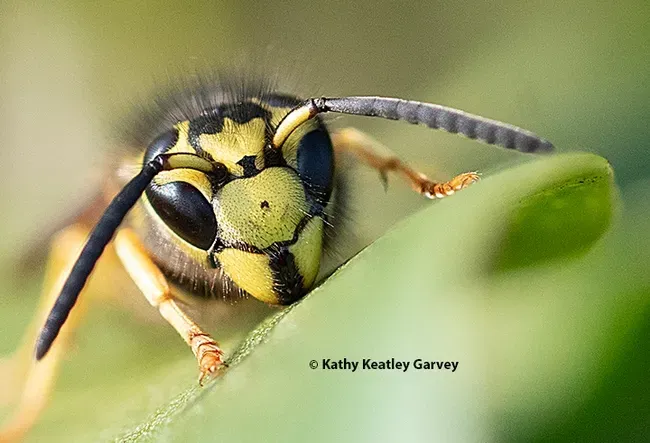
Beware of yellowjacket nests in our state parks--and elsewhere, as well!
Self-described "Wasp Woman" UC Davis Distinguished Professor Emerita Lynn Kimsey who directed the Bohart Museum of Entomology for 34 years until her retirement last year, continues to field many a question about insects, including the western yellowjackets, Vespula pensylvanica.
The SFGATE sought her out for its Aug. 5 piece on "Get Away as Fast as You Can': Bay Area Park Warns of Wasp Population." Although retired, Kimsey continues her research on Hymenoptera and publishes the Bohart Museum newsletter. She is a past president of the International Society of Hymenopterists (2002-2004). .
What's happening: Visitors to the Samuel P. Taylor State Park, a 2,800-acre state park in Marin County, are worried about the increasing number of yellowjacket nests and the attacks.
Peter Ostroskie, a spokesperson for California State Parks’ Bay Area District, told reporter Amanda Barlett that “Typically we see a few nests a year. This year, we have at least recorded over 10 nests that we know about.”

Parks officials cordoned off the nest sites in the day-use area and marked them with caution tape.
Kimsey, who wrote a fact sheet on yellowjackets on the Bohart Museum website, told SFGATE that the milder that winters become, the better the yellowjackets' ability to survive and forage.
Indeed, there's plenty of food that picnickers bring in. Wasps love a good barbecue (they're meat eaters) and they love sugary substances such as soft drinks.
"Typically, wasps form new colonies on an annual basis, producing a new batch of queens and males in the fall months," Barlett wrote. "They mate, the males die, and the queens go to find a space to hide out until the spring — they tend to prefer rodent burrows and other underground cavities."
Those are the annual nests. But there are perennial nests, too.
Kimsey says that a yellowjacket colony typically includes 50,000 to 100,000 workers, but one of her colleagues in Hawaii recently found a perennial nest with an estimated 3 million wasps.
Bottom line: Be observant. Avoid wasp nests. Watch for uninvited guests attending your barbecue or picnic. And watch your soda can to make sure that when you take a drink, you don't wind up with an angry wasp in your mouth.
And read the UC Statewide Integrate Pest Management Program's Pest Note on "Yellowjackets and Other Social Wasps."
"Yellowjackets are by far the most troublesome group, especially ground- and cavity-nesting ones such as the western yellowjacket, which tend to defend their nests vigorously when disturbed," UC IPM writes. "Defensive behavior increases as the season progresses and colony populations become larger while food becomes scarcer. In fall, foraging yellowjackets are primarily scavengers, and they start to show up at picnics and barbecues, around garbage cans, at dishes of dog or cat food placed outside, and where ripe or overripe fruit are accessible. At certain times and places, the number of scavenger wasps can be quite large."
UC IPM goes on to note that "Concern about yellowjackets is based on their persistent, pugnacious behavior around food sources and their aggressive defense of their colony. Usually stinging behavior is encountered at nesting sites, but sometimes scavenging yellowjackets will sting if someone tries to swat them away from a potential food source. When scavenging at picnics or other outdoor meals, wasps will crawl into soda cans and can sting your lips or the inside of your mouth or throat."
However, "Most social wasps provide an extremely beneficial service by eliminating large numbers of other pest insects through predation and should be protected and encouraged to nest in areas of little human or animal activity," UC IPM relates. "Although many animals prey on social wasps—including birds, reptiles, amphibians, skunks, bears, raccoons, spiders, praying mantids, and bald-faced hornets—none provides satisfactory biological control in home situations." (Read more on the UC IPM site)

